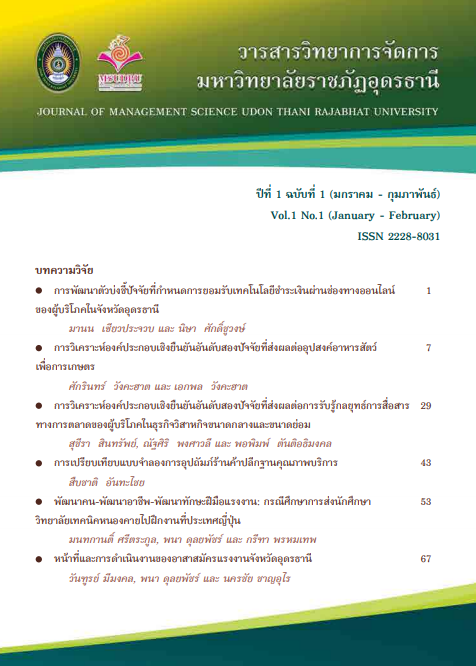การเปรียบเทียบแบบจำลองการอุปถัมภ์ร้านค้าปลีกฐานคุณภาพบริการ
Main Article Content
บทคัดย่อ
การศึกษาครั้งนี้มีวัตถุประสงค์เพื่อเปรียบเทียบแบบจำลองการอุปถัมภ์ร้านค้าปลีกของผู้บริโภค กล่าวคือ ผู้เขียนทำการตรวจสอบความสัมพันธ์เชิงโครงสร้างระหว่างของคุณภาพการบริการ บรรยากาศของร้านค้าปลีก และการตั้งใจซื้อของผู้บริโภค การวิจัยครั้งนี้เป็นเชิงสำรวจ โดยใช้แบบสอบถามเก็บข้อมูลจากผู้บริโภคที่เป็นกลุ่มตัวอย่าง จำนวน 399 ตัวอย่าง การศึกษาครั้งนี้ใช้แบบจำลองสมการ เชิงโครงสร้างประเมินความเที่ยงตรงของโครงสร้างด้านการลู่เข้ากัน และความเชื่อมั่นของตัวแปรแฝง การศึกษา พบว่า แบบจำลององค์ประกอบเชิงยืนยันชั้นที่ 1 ขององค์ประกอบ 3 ชนิด มีความสอดคล้องกับข้อมูลเชิงประจักษ์มากที่สุด
Article Details

อนุญาตภายใต้เงื่อนไข Creative Commons Attribution-NonCommercial-NoDerivatives 4.0 International License.
บทความที่ได้รับการตีพิมพ์เป็นลิขสิทธิ์ของคณะวิทยาการจัดการ มหาวิทยาลัยราชภัฏอุดรธานี
ข้อความที่ปรากฏในบทความแต่ละเรื่องในวารสารวิชาการเล่มนี้
ไม่ใช่ความคิดเห็นและความรับผิดชอบของผู้จัดทำ บรรณาธิการ กองบรรณาธิการ และคณะวิทยาการจัดการ มหาวิทยาลัยราชภัฏอุดรธานี ความรับผิดชอบด้านเนื้อหาและการตรวจร่างบทความแต่ละเรื่องเป็นความคิดเห็นของผู้เขียนบทความแต่ละท่าน
เอกสารอ้างอิง
สำนักงานเทศบาลนครอุดรธานี (2547). สำมะโนประชากร. อุดรธานี: สำนักงานเทศบาลนครอุดรธานี.
สืบชาติ อันทะไชย. (2551). อิทธิพลเชิงสาเหตุของภาพพจน์ร้านค้าปลีกต่อการตัดสินใจซื้อ. วารสารบริหารธุรกิจ. 120(ต.ค.-ธ.ค.), 9-29.
สืบชาติ อันทะไชย (2559). แบบจำลองสมการเชิงโครงสร้างทางการตลาด. กรุงเทพฯ.โอ.เอส. พริ้นติ้ง เฮ้าส์.
Bagozzi, R. P. (1984). A Prospectus for Theory Construction in Marketing. Journal of Marketing, 48(Winter), 11-29.
Bagozzi, R. P., & Yi, Y. (1988). On the Evaluation of Structural Equation Models. Journal of Academy of Marketing Science, 16(January-December), 74-94.
Bollen, K. A. (1989). Structural Equations with Latent Variables. NY: John Wiley & Sons.
Byrne, B. M. (1998). Structural Equation Modeling with LISREL, PRELIS, SIMPLIS: Basic concepts, applications, and programming. Mahwah, NJ: Lawrence Erlbaum Association.
Cronin, J., & Taylor, S. (1992). Measuring Service Quality: A reexamination and extension. Journal of Marketing, 56(July), 55-88.
Donovan, R. J., & Rossiter, J. R. (1982). Store Atmosphere: An Environmental Psychology Approach. Journal of Retailing, 58(1), 34-57.
Feeny, A., Vongpatanasi, T., & Soonsatham, A. (1996). Retailing in Thailand. International Journal of Retailing and Distribution Management, 24(8), 38-44.
Fornell, C., & Larcker, D. F. (1981). Evaluating Structural Equation Models with Unobservable Variables and Measurement Error. Journal of Marketing Research, 18(February), 39-50.
Gutman, J. (1982). A Means-End Chain Model Based on Consumer Categorisation Processes. Journal of Marketing, 46(Spring), 60-72.
Heider, R., & Moeller, S. (2012). Outlet patronage in on-the-go consumption: An analysis of patronage preference drivers for convenience outlets versus traditional retail outlets. Journal of Retailing and Consumer Services, 19(January-December), 313-324.
Kim, J., Fiore, A. M., & Lee, H-W. (2007). Influences of online store perception, shopping enjoyment, and shopping involvement on consumer patronage behavior towards an online retailer. Journal of Retailing and Consumer Services, 14(January-December), 95-107.
Lee, H. J., & Yang, K. (2013). Interpersonal service quality, self-service technology (SST) service quality, and retail patronage. Journal of Retailing and Consumer Services, 20(January-December), 51-57.
Luceri, B., & Laturi, S. (2012). The importance of consumer characteristics and market structure variable in driving multiple store patronage. Journal of Retailing and Consumer Services, 19(January-December), 519-525.
Olson, J. C., & Jacoby, J. (1972). Cue Utilization in the Quality Perception Process. in Proceedings of the Third Annual Conference of the Association for Consumer Research, Pages 167-179. Chicago, IL: Association for Consumer Research.
Pan, Y., and Zinkhan, G. M. (2006). Determinants of retail patronage: A meta-analytical perspective. Journal of Retailing, 82(3), 229-243.
Paramuraman, A., Zeithaml, V. A., & Berry, L. L. (1988). SERVQUAL: A multiple-item scale for measuring consumer perceptions of service quality. Journal of Retailing, 64(1), 12-40.
Samli, A. C. (1998). Strategic Marketing for Success in Retailing. NY: Quorum Books.
Zeithaml, V. A. (1988). Consumer Perceptions of Price, Quality, and Value: A means-end model and synthesis of evidence. Journal of Marketing, 52(3), 2-22.


